
We completed the third wave in our COVID research “trilogy.” This time around, more than 350 stations across North America took part to learn how their core listeners were planning for what promises to be the most anomalous holiday season ever.
Will they go out shopping or choose more convenient online e-commerce options? Will they be indulging in personal travel or vacations this season? What will family gatherings be like during a COVID Christmas?
Paul Jacobs was the “showrunner” for this study. He posited that if radio sellers and marketing strategists were armed with fresh, relevant data, they’d be able to make the most out of the most challenging year ever for the medium.
He has spent his career in radio sales, first as a seller, than a sales manager, a general manager, and as my partner at Jacobs Media/jacapps for nearly three decades. Paul’s the yang to my yin, complementing my programming side well. And unlike some PDs and GSMs, we actually see eye-to-eye on most things.
And now that we’ve presented the study to its stakeholders, as well as to RAB members (our partners for this study), Paul reflects on what this data means for radio sales staffs, whether they’re in Atlanta or Altoona. – FJ
For as long as I’ve been involved in selling radio, I have always heard the idyllic term, “consultative sell.” For some, this meant creating bonds with clients beyond simply selling them spots or remotes. It translated into identifying their needs and helping solving their problems with the tools of the trade – great creative, personality endorsements, contests and giveaways – you name it.
But for others, it was just about selling spots and delivering their station’s cume – your basic reach and frequency. And it only really worked when advertisers didn’t have a lot of media options.

In the past two decades, even more retailers know they have an abundance of marketing options at their disposal. There’s myriad digital agencies, Facebook and Google are knocking on their doors with targeted solutions, not to mention SEO, SEM, re-targeting, and let’s not forget radio’s traditional media competitors, outdoor, television, and print.
And now there are clusters of radio stations creating packages that even bonus entire FM radio stations – whatever it takes to get on the buy, especially during these COVID times.
Now that we’re in the final throes of 2020, the sales and marketing landscape has become even more complex. Not only do advertisers still have these many options (at lower, competitive rates in many cases), but their needs have changed. Pre-pandemic, the goal of advertising was primarily to hammer price and item, drive traffic into stores, encouraging shoppers to browse the aisles, talk to helpful salespeople, and make that purchase.
Today, most consumers are seeking a different experience, often concerned as much about safety protocols, curbside shopping, and e-commerce options.
Ahh, the good old days.
Since the release of our COVID 3 research, another study has recently come to light that echoes our findings. They indicate many retailers are poorly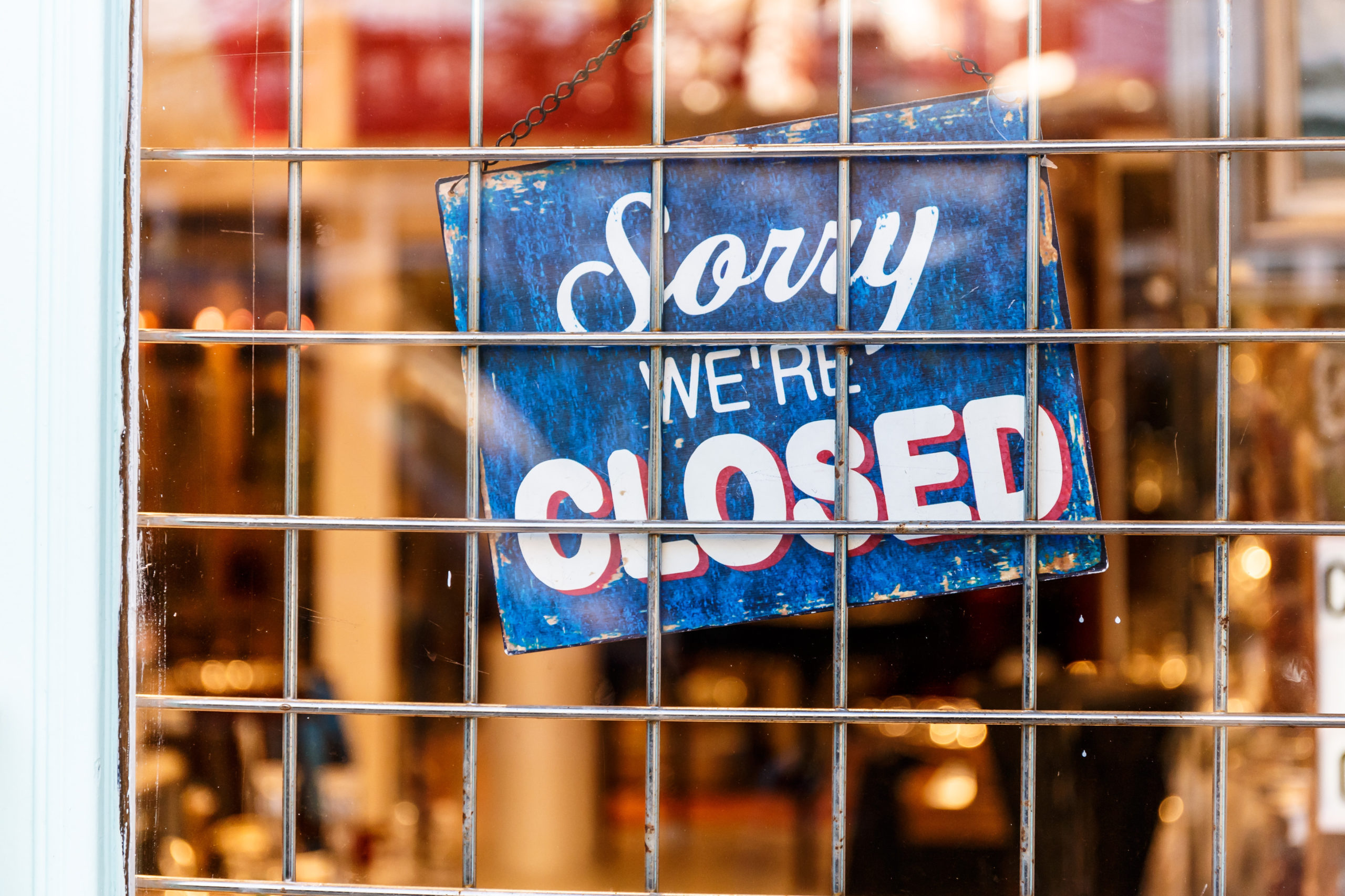 prepared to adjust to the new shopping realities, and now, radio stations have a road map to help them navigate through the holiday shopping season and beyond.
prepared to adjust to the new shopping realities, and now, radio stations have a road map to help them navigate through the holiday shopping season and beyond.
The first was conducted in August for PayPal by Netfluential and covered in Business Insider. It finds that astonishingly, nearly six in ten (57%) retailers hadn’t started their planning for their holiday shopping season. While they are likely strategizing about how to decorate their stores inside and out, too few are prepared for the rapidly shifting needs of consumers due to the pandemic and eight months of altered lifestyles.
Each year in January, the news media is filled with stories about retailers that suffered epic fails due to a lackluster holiday season. And these are usually mega brands like JC Penny.
But local radio stations should be concerned about the health and welfare of smaller businesses in their local communities – not just how much of their holiday budget is allocated to radio. Instead, the true test of these holidays will be whether many of these local enterprises will even make it to Valentine’s Day. And the research clearly shows, not enough of them are responding quickly or strategically enough to have a fighting chance at survival.
Or as Suzanne McGrath, a small business counselor and SCORE mentor in Washington, D.C. points out, “Though it’s natural to want to take the wait-and-see approach, experts caution there’s no time to waste. In fact, the National Retail Federation’s 2020 winter trends survey shows that retailers expect consumers to start holiday shopping as early as October. That means if you haven’t started your holiday sales prep, you should start ASAP.”
We learned the same thing in COVID 3. Christmas, Hanukkah, and Kwanzaa shopping has already begun for many consumers, ostensibly hoping to miss the mad rush and packed crowds of Black Friday, once a fun event that now may be perceived by many as a horror show.
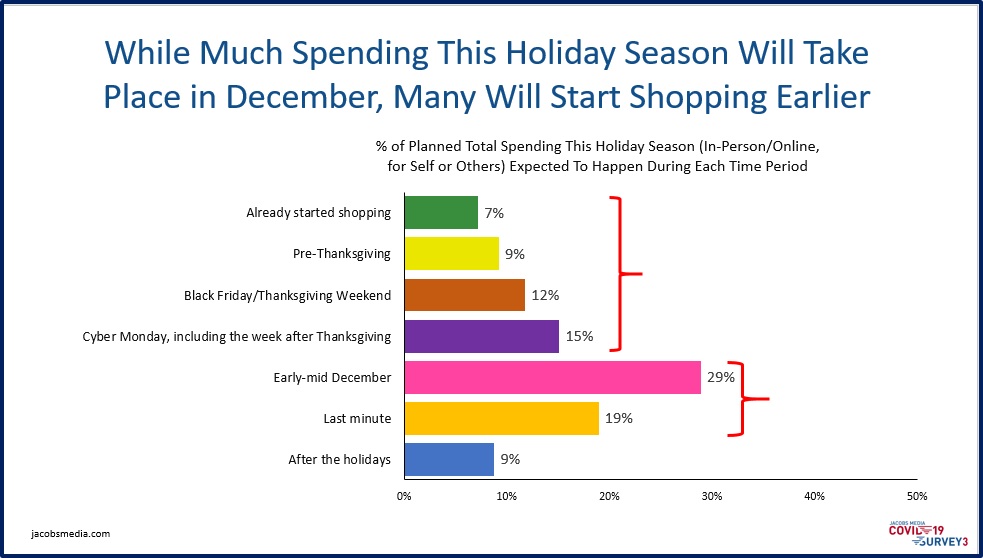
If there was ever a time for radio salespeople to pivot and start focusing on consulting their clients about survival tips this holiday season, it’s right now. And that’s where our COVID 3 study comes into play.
It provides rich insights into what shoppers are expecting, if and when they decide to set foot in physical stores to shop. If I was selling radio today or leading a sales team, I’d download it, study it, and hit the streets today in order to help our clients navigate the holidays while positioning my station as an invaluable partner committed to your mutual success.
We’ve created Action Steps to go along with the key findings. While it’s nice to have data and pretty slides, they don’t amount to much without a strategic plan.
So, here you go – free consulting from a consultant (how’s that for the consultative sell?):
1. Recalibrate your sales strategy – The reasons why are obvious during this odd wrinkle in time. Your biggest asset – your audience – will behave differently this season. That includes how they react to advertising and make decisions about when and where to shop.
Sure they want deals, but they are less likely to go into a store that does not have a facemask policy. More than ever before, shoppers are willing to shift their dollars to e-tailers if they think it will keep them safe. So, coming up with that great Black Friday package isn’t going to work like it used to if your advertisers aren’t calibrated to the new reality of shopping during a worsening pandemic.
2. Start advertising now – Our study found that more than four-in-ten (43%) started their holiday shopping well before December (some long ahead of Halloween), with growing activity around the traditional Black Friday and Cyber Monday milestones.
Yes, it varies by demographics. Not surprisingly, male shoppers are more likely to wait until December. But with this many people already shopping, advertisers shouldn’t wait to start their spending. This is actually good news for radio because an elongated holiday shopping season makes better use of available inventory – especially when political ad spending comes to a grinding halt next week.
Soon after we released COVID 3, we saw this ad for Walmart, announcing their strategy to spread out Black Friday deals across three weekends in an effort to lighten the crowds, take advantage of consumer concerns, and capitalize on a lengthier shopping cycle. And note their emphasis on e-commerce – “online doorbusters” – a shopping option that has already paid off in spades for the Bentonville, Arkansas, juggernaut. Of course, your local clients can do the same, armed with timely information.

3. It’s all about safety – The research shows a key driver in deciding where to shop is whether or not it will be a safe experience. This information needs to be shared with local advertisers, as well as reflected in ad copy and other communications to shoppers. Women are far more passionate about a safe shopping experience, and I don’t have to tell you about their value this holiday season. Facemask policies, touchless shopping, sanitation procedures, and other services need to be part of any advertising campaign and communication strategy.
As Suzanne McGrath reminds, “All these practices are not only good but critical. The key, though, is marketing them. The environment must not only be safe; customers must know it is safe. Referring to objective standards like CDC guidelines can give customers confidence that the business is going above and beyond to ensure safety. Interestingly, many customers also like to know that the business is as concerned about employee safety as it is about customer safety.”
There’s no other ad medium that’s better, more efficient, and more effective than local radio when it comes to communicating these all-important new shopping messages.
4. Promote COVID inspired new services – Along with safety, consumers want to know how stores plan to make the shopping experience easier, 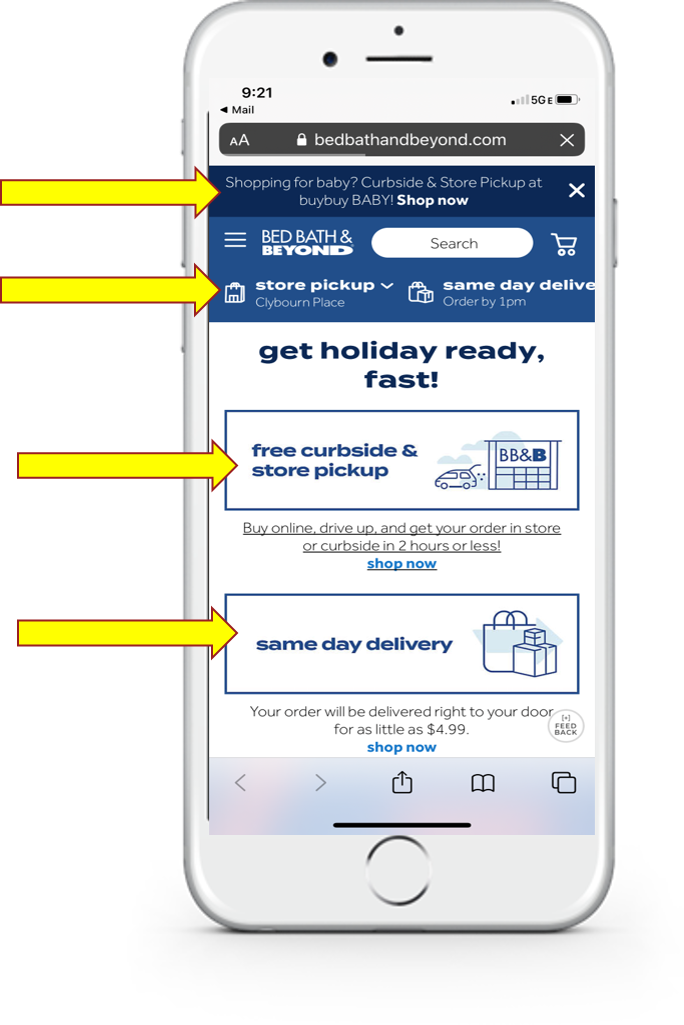 more seamless and convenient, and safer. These include extras such as curbside pickup, home delivery, and of course, e-commerce options. If a retailer isn’t providing online ordering on their website and mobile app, it is likely to be a blue Christmas. These are all areas where tuned-in radio “sales consultants” can help them.
more seamless and convenient, and safer. These include extras such as curbside pickup, home delivery, and of course, e-commerce options. If a retailer isn’t providing online ordering on their website and mobile app, it is likely to be a blue Christmas. These are all areas where tuned-in radio “sales consultants” can help them.
It should come as no surprise that big retail players have already figured this out. Check out the messages Bed, Bath, and Beyond is sending on their mobile app – it’s not about cheap towels or coffee grinders – it’s about promoting their COVID-safe services front and center.
5. Help local clients develop e-commerce options – One of the smartest things many broadcasters have done over the past few years is creating separate divisions that provide digital products, solutions, services, and expertise for advertisers. While many of these have become solid growth centers, they now put their parent companies in position to quickly pivot to help retailers who don’t Amazon from apples.
Our COVID study found that two-thirds (67%) of radio fans plan to do at least half their holiday shopping online this year. This doesn’t have to mean all their dollars will flow through Walmart, Target, or Amazon. That’s because our study also showed that a whopping eight in ten (79%) want to “support local/small businesses in my area.”
Thanks in large part of Jeff Bezos, e-commerce was already a huge deal pre-COVID. Millions of families and consumers are Amazon Prime subscribers.
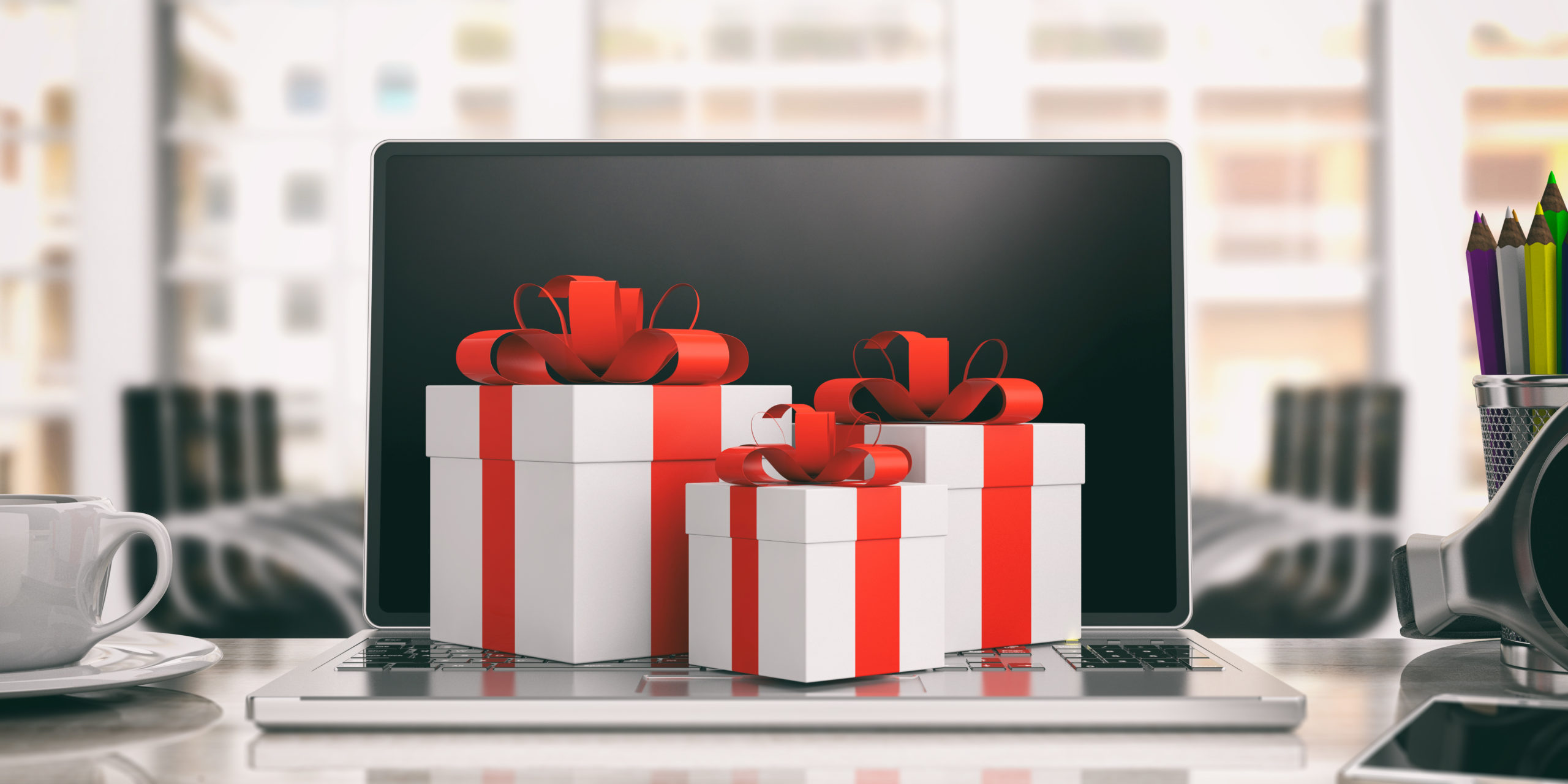 In 2020, etailing will be the game-changer, deeply impacting the personal retail shopping experience. Only local retailers that are prepared for this moment will prosper.
In 2020, etailing will be the game-changer, deeply impacting the personal retail shopping experience. Only local retailers that are prepared for this moment will prosper.
Dan Jablons, owner and retail consultant at Retail Smart Guys, a Los Angeles-based retail business consulting firm sees the same situation at play:
“Business owners are going to have to make sure their technology is set up to handle online purchases, deliveries, returns, and all of those things we’re seeing more and more of. Brick and mortar will continue to be an important component, but e-commerce is going to become a larger part of the mix.”
Having spoken with retailers and radio sellers about this sea change, the biggest barrier is many simply don’t know where to start – and that’s the opportunity for your consultative sell. First of all, if you have a digital agency, develop an e-commerce solution quickly. Or partner with a third-party provider like Shopify. Or make sure one person on your team is well-versed in eCommerce options, or create a client email or section on your website with all the information they need. In other words, many clients need help understanding where to start, and sellers need to be armed with this information.
6. Champion radio’s strengths – One of the most positive findings in our COVID 3 study was verifying the obvious – radio effectively drives audience 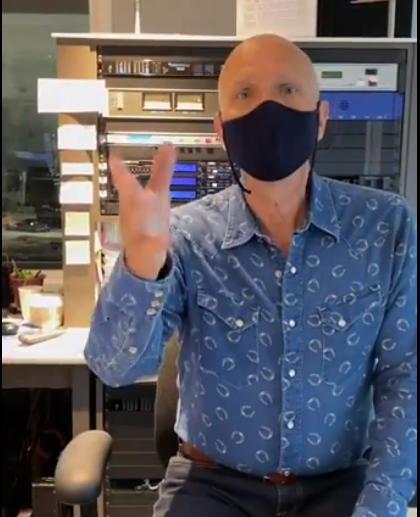 to local businesses via advertising as well as air personality endorsements. Keeping in mind our survey is comprised primarily of radio fans, ads on the radio ranked the highest (65%) among all media when asked what influences purchase decisions. And almost six in ten (57%) say endorsements from trusted personalities are effective.
to local businesses via advertising as well as air personality endorsements. Keeping in mind our survey is comprised primarily of radio fans, ads on the radio ranked the highest (65%) among all media when asked what influences purchase decisions. And almost six in ten (57%) say endorsements from trusted personalities are effective.
This bodes well for radio sellers looking for a holiday story. The medium is well-positioned to help local retailers succeed – and survive. But don’t assume your clients are aware of this – you now have the data to verify it.
7. Expand your geographic target – How many of you are thinking of getting on a plane this holiday season? Our COVID 3 research says more than half (55%) of consumers are planning no personal travel this quarter. And of those who do, the majority will be in the relative safety of their cars, SUVs, and RVs, or as we call them in Detroit, mobile personal protective equipment.
I don’t think we’re going to be seeing local television reporters standing in jam-packed airport lobbies the day before Thanksgiving talking about “the busiest travel day of the year.” COVID has changed everything.
So, expand your target this holiday season – look closely at shopping areas, major malls, entertainment, sports and family activities and other venues within a 200-300 mile radius, share this information and turn them into advertisers.
And we are already hearing reports of communities and downtown shopping areas creating drive-through holiday lighting exhibits, where families can experience the season safely while getting out of the house.
Also, don’t forget to remind your audience that while they are on their driving holiday, they can take your station with them via your mobile app.
8. Make it a happy holiday season – It’s going to be a bittersweet, challenging time for millions of us this year. Family traditions will be disrupted, while many traditional events will be cancelled.
This is an opportunity for your advertisers – and your station – to become a source of happiness and joy during a time when things will be different. And yet, the season may become even more meaningful this year.

Access our COVID 3 study, “Radio’s 2020 Holiday Road Map,” here.
- For Radio, Will It Be Christmas In April (And Hopefully, May)? - April 21, 2025
- The Revolution Will Not Be Monetized - December 30, 2024
- What Kind Of Team Do You Want To Be? - October 4, 2024




Seems as though radio groups/operators would do well to offer an easy access ecommerce solution for local advertisers. Your study says that their customers are more likely to respond to radio ads and they really need to be competitive with the bigger retailers with online options this year. it might make a nice piece of added value to a media schedule of a minimum of “X” dollars.